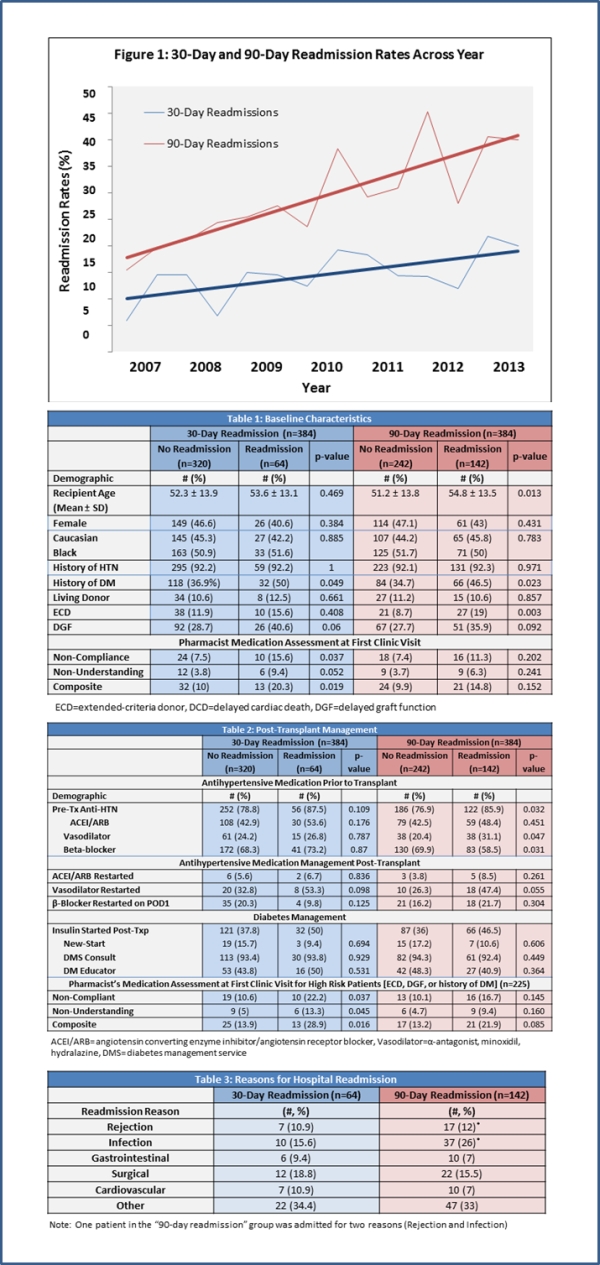Patient and Process-Level Factors Associated With Kidney Transplant Readmissions
MUSC, Charleston, SC.
Meeting: 2015 American Transplant Congress
Abstract number: 203
Keywords: Kidney transplantation, Outcome, Risk factors
Session Information
Session Name: Concurrent Session: Kidney: Hospitalization/Readmission
Session Type: Concurrent Session
Date: Monday, May 4, 2015
Session Time: 2:15pm-3:45pm
 Presentation Time: 3:03pm-3:15pm
Presentation Time: 3:03pm-3:15pm
Location: Room 118-AB
Readmissions following kidney transplantation (KTX) are common, with complex etiologies. There is a lack of research exploring the potential of optimizing post-transplant processes to reduce readmission. An observed increase in readmission rates at our center from 2007 to 2013 (Figure 1) led to this study, aimed at assessing patient factors and process-level breakdowns on the risk of 30 and 90-day readmissions.
Methods: Retrospective longitudinal case control study in adult solitary KTX patients transplanted between Aug 2011 and Dec 2013. Univariate and multivariate analysis were utilized to assess for patient and process determinants of 30 and 90-day readmissions.
Results: Regarding patient-specific factors, the incidence of diabetes, delayed graft function, and ECD use have all increased since 2007 (data not shown). These factors were also associated with increased risk of 30 or 90-day readmission in the current analysis between 2011 and 2013 (Table 1). Additionally, 30-day readmission rates were strongly associated with pharmacist identification of patient lack of knowledge about medications in all patients studied (OR: 2.294, p=0.019). When looking specifically at high risk patients [ECD, DGF, or history of DM], having poor medication understanding or adherence significantly increased the risk of 30-day readmissions and trended toward significance for 90-day readmissions (Table 2). Regarding process measures, both 30 and 90-day readmission rates were influenced by re-initiation of vasodilator therapy (Table 2). Finally, reasons for readmissions are depicted in Table 3.
Conclusion: These data suggest the increase in readmission rates is due to both patient-level and process-level factors. Recent increases in the incidence of DM and DGF, coupled with the use of ECDs have likely increased readmissions rates. Process-level characteristics, specifically pharmacist assessment of knowledge about post-transplant medications, especially in high risk patients, and re-initiation of antihypertensive may converge with these patient-level risks to drive early hospital readmission in KTX. 
To cite this abstract in AMA style:
Covert K, Fleming J, Staino C, Casale J, Boyle K, Pilch N, Meadows H, Mardis C, McGillicuddy J, Bratton C, Srinivas T, Chavin K, Baliga P, Taber D. Patient and Process-Level Factors Associated With Kidney Transplant Readmissions [abstract]. Am J Transplant. 2015; 15 (suppl 3). https://atcmeetingabstracts.com/abstract/patient-and-process-level-factors-associated-with-kidney-transplant-readmissions/. Accessed January 8, 2026.« Back to 2015 American Transplant Congress
